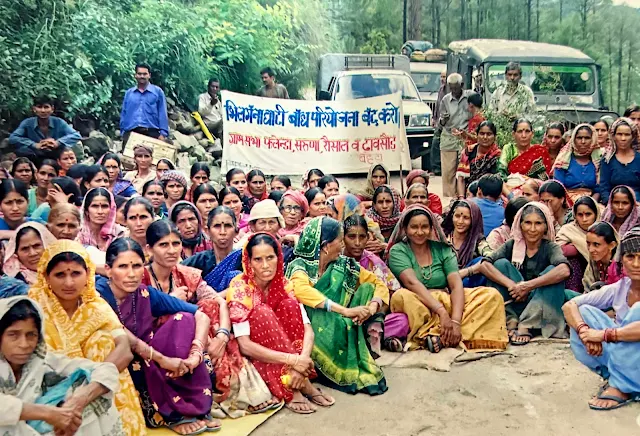Most Himalayan villages are extremely beautiful. However we cannot afford to ignore some deeply worrying ecological and social aspects of these villages, particularly as in some contexts these show an increasing trend.
The Himalayan landscapes can present very majestic views. However the reality is that in geological terms the Himalayas are fragile, young and unstable. Their most persistent message, if only we heed this, is ‘handle with care’. Unfortunately this simple message has been neglected all too often.
As big business interests indulge in indiscriminate construction and mining activities with the blessings of corrupt officials and politicians, the vulnerable hills are weakened by blasting work and operations of heavy machines. In some places the fragile hills are overburdened with careless heavy construction. Dam builders often do not exercise adequate care to observe all the safety precautions or heed even those warnings that have a sound scientific base. The debris of construction work is often thrown into rivers increasing the destructive capacity of floods, or else it is dispersed around carelessly increasing the harm from landslides. Indiscriminate mining plays havoc with fragile hills.
Sand mining in rivers increases threat of erosion and floods, and as even areas crucial for safety, such as those near bridge pillars, are not spared, threat of bridge collapse increases. Trees are felled in huge numbers in the hurry to execute big construction and mining projects, ignoring many-sided ecological harm and destabilization of slopes caused in the process.
All these factors have been intensified at a time when instead there should have been much greater restraint in response to the worsening disaster situations related to climate change. In recent times there have been more incidents of excessive rain concentrated in very short periods, leading to higher possibility of disaster situations such as flash floods. In such conditions when additional problems are created by indiscriminate construction and mining activities, then the possibility of disasters such as landslides, floods and flash floods increases and the destructive capacity of disasters also increases, as has been seen several times in recent years.
At the same time, problems related to droughts and water-scarcity also increase as the reverse side of the same ecological destruction when water springs are depleted or destroyed and other traditional water sources are also harmed. With weather pattern changing and the dry season often getting extended, the risks of forest fires have increased, but some man-made factors have also contributed to this.
Keeping in view the natural beauty, biodiversity and forests, various traditional skills and openings for new ones, as well as other assets of the Himalayan region, old livelihoods can be strengthened in new ways and several new income earning opportunities which are not harmful for environment can be promoted here in a significant way but as this could not happen adequately in many places, particularly in some of the more remote areas, the pattern of depending on migration to support families that stay back in villages has persisted in many villages. In some of the remote areas, in the absence of proper development efforts as well as increasing risks of disasters, several villages have seen even larger-scale and more permanent migration. In these areas it will become more difficult to take up several protective works as well, including controlling forest fires.
There are several Himalayan communities that have evolved distinct life and livelihood patterns in keeping with local conditions. It is very important to understand their life-patterns and their knowledge of local conditions should be respected and utilized in proper ways. Unfortunately this is often neglected. In the case of various nomadic and semi-nomadic communities, for example, their life patterns have not been properly appreciated with the result that they have to face imposition of policies not suitable for them.
Over-centralization of decisions and plans without giving due consideration to possible adverse impacts on people has frequently proved very harmful.
Various adverse impacts can be even more harmful for the poorer people and weaker sections who are already living on the margins. The more serious and many-sided problems of the dalit communities in several parts of the region have not received adequate attention, particularly in Uttarakhand state where the adverse impact of anti-dalit feelings spread at the time of the agitation for a separate state has added to other woes of the dalit community.
The high consumption of liquor and other intoxicants in many villages has been a matter of serious concern. The problem became more serious with the opening up of several liquor vends closer to villages.
Due to all these factors distress and risks can be high in several villages even though these villages appeal to outsiders greatly due to their natural beauty.
The Himalayan region needs a combination of development reform and social reform. There should be reform of development planning which is in keeping with the real needs of the region’s people, with emphasis on decentralization, environment protection and special care of weaker sections. Women with their great contribution to farming and rural economy should be at the center of decentralized planning and decision making. Dalits and the poorest, weakest households, including all those who may have faced isolation or injustice in the past, should get special attention for ensuring their protection and welfare. Tourism should be seen more in terms of helping rural and ordinary people than in terms of promoting big hotels, and in this context eco-protective tourism should get special attention. Folk arts and folk artists as well as crafts-persons should get more support and encouragement.
---
The writer is Honorary Convener, Campaign to Save Earth Now. His recent books include Planet in Peril, Protecting Earth for Children, A Day in 2071, and Man over Machine



Comments